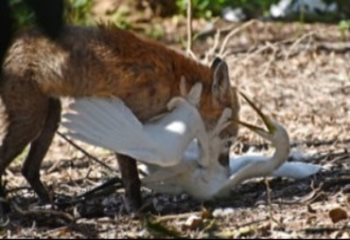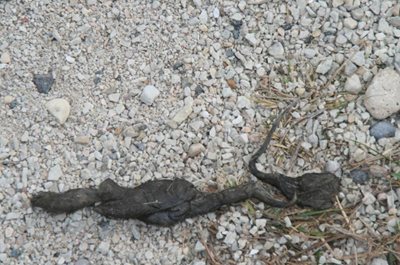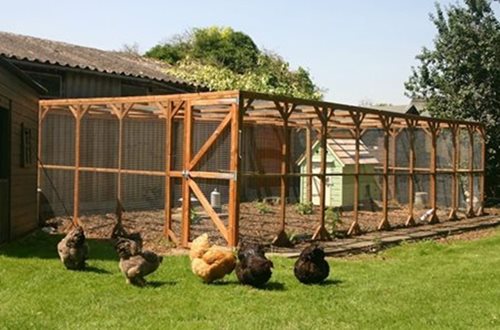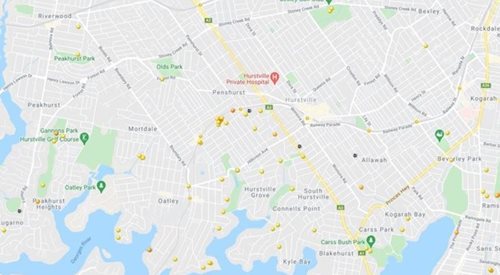The European Red Fox came to Sydney around 150 years ago and has directly caused the extinctions of many native animals since then. 
Native Australian animals didn’t evolve with foxes and have not developed strategies to avoid fox predation. As a result, native species as varied as reptiles, frogs and insects are easy prey to foxes and other introduced predators. Ground-dwelling native animals and freshwater turtles are particularly at risk. In June 2015, a single fox killed a quarter of the Little Penguin population in Manly in under two weeks.
Foxes regularly attack and kill uncaged chickens at night and may also harass and injure pet dogs and cats.
What is Council Doing?
Council runs an ongoing Fox Management Program which includes community education, capacity building and fox cage and soft jaw leg-hold trapping using professional, licensed contractors in Council managed bushland reserves.
Reserves subject to trapping are signposted at major entrances and listed on this page during the trapping period.
The use of soft jaw leg-hold traps were approved at Council's Meeting on 11 March 2019 and are regulated through the Prevention of Cruelty to Animals Act 1979 S23.
All traps are monitored daily by either motion-detector cameras or the contractor.
This program does not use 1080 fox poison baiting.
How Can You Help?
You can report fox sightings or fox attacks on the Fox Scan website.
You can also help prevent foxes inhabiting Georges River by reading Council's Fox Education Guide and following these tips:
- Don’t leave pet food outside overnight
- Use enclosed compost bins
- Keep domestic animals secure at night
- Remove fallen fruit around fruit trees
- Keep garbage bins covered
- Close off access underneath buildings
- Use fox-proof enclosures for poultry
- Turn off outside lights that might attract insects; and
- Reduce weeds on your property.
Frequently Asked Questions
-
How to identify a fox

Foxes can be identified through their kills or scat (poo).
Fox Scat Identification
-
Fox scats are like small dog scats; but are thinner and have a distinct curved tail on the end.
-
Fox scats will contain hair, seeds and bone due to their unique omnivorous diet.
Further information is outlined in Council's Fox Education Guide.
-
How to fox-proof a chicken enclosure
Keeping chickens is a good way to source your own food and keep weeds down. Council supports residents who choose to do so, provided these NSW regulations for chicken coops are followed:
- Limited to a floor area of 15m2

- A maximum height of 3m above ground level (existing)
- Located in the rear yard
- Limited to one per property
- A distance from the boundary of 3m
- Located at least 4.5m from any dwelling, public hall, school or premises used for the manufacture, preparation, sale or storage of food
- Made of materials that blend with the environment and be non-reflective
- Adequately drained
- Paved with concrete, mineral asphalt, or situated on clean sand underneath the roosts or perches
- Occupied by no more than 10 fowls or poultry.
Keep those foxes out!
You can make your chicken coop fox-proof using these tips:
- Fences should be no less than 1800mm high and constructed with thick, 0.9mm wire with gaps no less than 80mm
- Fences should be curved outwards at the top to prevent a fox jumping over and stretch out 450mm at the bottom either under or above ground
- Gates should remain locked when not in use, ideally with a padlock or self-closing mechanism.
If you follow these tips and make sure to report any wily fox activity in your area to FoxScan, your chickens will enjoy a far better quality of life!
Sutherland Shire Council runs chook keeping workshops and has some more information about safely keeping chickens on their website.
-
How to report a fox sighting
You can report fox sightings to Council on 9330 6400, visiting FoxScan or by downloading the FeralScan Application.
The following general tips will also help:
- Not leaving pet food out overnight
- Using enclosed compost bins
- Removing fallen fruit at base of garden trees and on lower branches
- Keeping garbage bins and skip bins covered
- Keeping domestic prey animals such as poultry in fox-proof enclosures; and
- Join a local Bushcare group to help control fruit-bearing weeds

Recorded fox sightings in Georges River Council's LGA- January 2021 to January 2022. Source: FoxScan
-
Where to find more information
Thank you for your feedback.